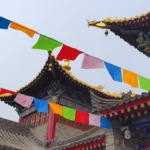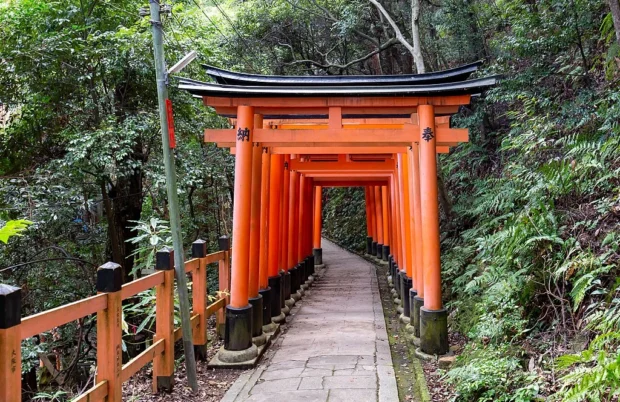When you think of Kyoto, Japan, the image of thousands of bright red torii gates winding up a forested mountain often comes to mind. This is the famous Fushimi Inari Shrine, a must-see attraction known for its rich history, spiritual importance, and breathtaking pathways. Located just a short distance from Kyoto’s city center, the shrine is easy to reach by train or bus. Nearby, you will find cozy guesthouses and traditional inns perfect for resting after exploring. For local flavor, try the nearby food stalls offering Inari sushi, a sweet and savory treat named after the shrine itself. Whether arriving from Kansai International Airport or Kyoto Station, transportation is straightforward-a quick train ride will bring you close to this iconic shrine.
Table of Contents
If you have some extra time in Japan, the nearby city of Osaka reveals vibrant landmarks and local flavors that beautifully complement Kyoto’s serene spiritual sites.
Walking Through History: The Origins of Fushimi Inari
Fushimi Inari Shrine dates back to the early 8th century, making it one of Japan’s oldest and most important Shinto shrines. Dedicated to Inari, the god of rice, agriculture, and business success, it has attracted worshippers seeking good fortune for over 1,300 years. What makes this shrine especially fascinating is the deep connection between spiritual beliefs and daily life in Japan. The thousands of bright red torii gates symbolize donations from individuals and companies, each hoping for blessings and prosperity.
Legend says that foxes, considered Inari’s messengers, appear here in many forms. Statues of foxes holding keys to rice granaries guard the paths, believed to bring protection. These spiritual and cultural layers give the shrine a special atmosphere that visitors feel instantly.
Finding Your Way: Directions and Getting There
Fushimi Inari Shrine is located just southeast of Kyoto’s busy downtown area. The easiest way to reach it is by train:
- From Kyoto Station, take the JR Nara Line to Inari Station. The ride lasts about 5 minutes.
- Once you exit Inari Station, you will see the shrine entrance just across the street.
If arriving from Kansai International Airport, take the JR Haruka Express directly to Kyoto Station, then transfer to the JR Nara Line as above. Buses are also available, but trains are faster and more convenient. Walking from central Kyoto takes around 25 minutes and offers a chance to see local neighborhoods.
Nearby Accommodation
Several charming guesthouses and traditional inns (ryokans) are located within walking distance. Staying nearby lets you visit the shrine early or late in the day, avoiding crowds. Plus, many accommodations offer local meals and quiet atmospheres perfect for recharging.
Tasting Local Food Near Fushimi Inari
Close to the shrine’s main entrance, local vendors sell ‘inarizushi’-small pockets of fried tofu stuffed with sushi rice. It’s a delicious snack perfect for enjoying on the go. Also, try traditional green tea or warm miso soup at nearby cafes. Exploring these tastes adds a sensory dimension to your visit.
If you love walking through historic and spiritual sites in Kyoto, then the shimmering beauty of Golden Kinkaku-ji offers a peaceful contrast with its tranquil gardens and rich artistic heritage.
After enjoying the vibrant trails of Fushimi Inari Shrine, consider visiting Kiyomizu-dera Temple nearby for stunning views and a different glimpse into Kyoto’s timeless spiritual heritage.
Best Time to Visit: Catch the Serenity of Fushimi Inari
While many visitors come during the daytime, the best moments to visit the shrine are early morning or late afternoon. During these quieter hours, you can enjoy the peaceful sound of footsteps on gravel and birds in the trees, surrounded by the vibrant vermilion gates. Weekdays are less crowded compared to weekends, especially outside of Japanese holidays.
Springtime brings lush greenery and spring flowers, while autumn illuminates the mountain with gorgeous red and orange leaves. Night visits offer a mysterious ambiance with some paths softly lit, but be aware that most shops close early and there is limited lighting deep into the trails.
Walking the Mountain Path: What to Expect Inside the Shrine
The heart of the shrine is the “Senbon Torii” or “thousands of torii gates” pathway. This famous trail begins near the main shrine building and winds up Mount Inari for about 4 kilometers. Along the way:
- You will find hundreds of bright red torii gates lined side-by-side, creating a mesmerizing tunnel effect.
- Smaller shrines and many fox statues appear at intervals.
- The full hike to the summit takes around 2 to 3 hours at a relaxed pace.
You don’t have to complete the entire hike to experience the beauty. Many visitors turn back halfway at the Yotsutsuji intersection, which offers a stunning view over Kyoto city.
Do You Need a Tour or Reservation?
The good news is that Fushimi Inari Shrine welcomes visitors freely. No reservation or entry fee is required, making it easy to drop by anytime during opening hours. The shrine is open 24 hours daily, though most visitors come between 6 am and 6 pm.
Guided tours are available through local travel companies if you want deeper insights into the history and symbolism. However, many enjoy walking the shrine paths at their own pace, soaking in the atmosphere quietly. Guides can enrich the experience with stories and cultural explanations but are not necessary for a fulfilling visit.
Little-Known Stories and Fun Details
Many visitors miss some playful and fascinating aspects of Fushimi Inari Shrine:
- The color red is believed to ward off evil spirits and illness. That’s why the gates shine so brightly.
- The fox statues sometimes wear red bibs left by worshippers, a symbol of protection and gratitude.
- Look closely at the inscriptions on each torii gate; they show the donor’s name and donation date, offering a glimpse of Kyoto’s economic history.
- The mountain is not just for tourists; many local worshippers hike there regularly as a spiritual ritual.
These details add layers of meaning to your visit, moving it beyond just beautiful photos.
Visit Official Fushimi Inari Shrine Website
For up-to-date information on events, access, and cultural matters, check out the official Fushimi Inari Shrine website. It offers useful details for planning your visit and learning more about this ancient spiritual site.

A Chinese tour guide with deep knowledge of the Far East, its traditions, and culinary secrets.
- 20181110 Fushimi Inari Torii 12 by Balon Greyjoy on Wikimedia Commons – cc0
